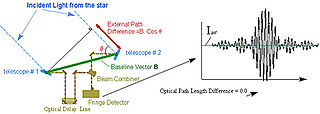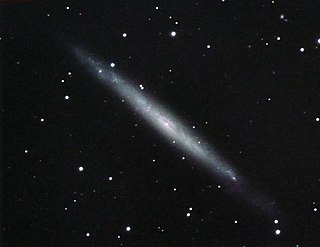
Astrometry is the branch of astronomy that involves precise measurements of the positions and movements of stars and other celestial bodies. The information obtained by astrometric measurements provides information on the kinematics and physical origin of the Solar System and our galaxy, the Milky Way.

In astrophysics and physical cosmology, Olbers' paradox, named after the German astronomer Heinrich Wilhelm Olbers (1758–1840), also known as the "dark night sky paradox", is the argument that the darkness of the night sky conflicts with the assumption of an infinite and eternal static universe. In the hypothetical case that the universe is static, homogeneous at a large scale, and populated by an infinite number of stars, then any line of sight from Earth must end at the surface of a star and hence the night sky should be completely illuminated and very bright. This contradicts the observed darkness and non-uniformity of the night.

Star clusters are very large groups of stars. Two types of star clusters can be distinguished: globular clusters are tight groups of hundreds to millions of old stars which are gravitationally bound, while open clusters, more loosely clustered groups of stars, generally contain fewer than a few hundred members, and are often very young. Open clusters become disrupted over time by the gravitational influence of giant molecular clouds as they move through the galaxy, but cluster members will continue to move in broadly the same direction through space even though they are no longer gravitationally bound; they are then known as a stellar association, sometimes also referred to as a moving group.

Astronomy is a natural science that studies celestial objects and phenomena. It uses mathematics, physics, and chemistry in order to explain their origin and evolution. Objects of interest include planets, moons, stars, nebulae, galaxies, and comets. Relevant phenomena include supernova explosions, gamma ray bursts, quasars, blazars, pulsars, and cosmic microwave background radiation. More generally, astronomy studies everything that originates outside Earth's atmosphere. Cosmology is a branch of astronomy. It studies the Universe as a whole.

The Andromeda Galaxy, also known as Messier 31, M31, or NGC 224 and originally the Andromeda Nebula, is a spiral galaxy approximately 2.5 million light-years from Earth, and the nearest major galaxy to the Milky Way. The galaxy's name stems from the area of the Earth's sky in which it appears, the constellation of Andromeda.

An astronomical object or celestial object is a naturally occurring physical entity, association, or structure that exists in the observable universe. In astronomy, the terms object and body are often used interchangeably. However, an astronomical body or celestial body is a single, tightly bound, contiguous entity, while an astronomical or celestial object is a complex, less cohesively bound structure, which may consist of multiple bodies or even other objects with substructures.

During 1944, Walter Baade categorized groups of stars within the Milky Way into stellar populations. By the way, in the abstract of the article by Bade, he recognizes that Jan Oort originally conceived this type of classification in 1926: "[...] The two types of stellar populations had been recognized among the stars of our own galaxy by Oort as early as 1926". Baade noticed that bluer stars were strongly associated with the spiral arms and yellow stars dominated near the central galactic bulge and within globular star clusters. Two main divisions were defined as Population I and Population II, with another newer division called Population III added in 1978, which are often simply abbreviated as Pop I, II or III.

A planetary system is a set of gravitationally bound non-stellar objects in or out of orbit around a star or star system. Generally speaking, systems with one or more planets constitute a planetary system, although such systems may also consist of bodies such as dwarf planets, asteroids, natural satellites, meteoroids, comets, planetesimals and circumstellar disks. The Sun together with the planets revolving around it, including Earth, is known as the Solar System. The term exoplanetary system is sometimes used in reference to other planetary systems.
Astrophysics is the branch of astronomy that employs the principles of physics and chemistry "to ascertain the nature of the astronomical objects, rather than their positions or motions in space". Among the objects studied are the Sun, other stars, galaxies, extrasolar planets, the interstellar medium and the cosmic microwave background. Emissions from these objects are examined across all parts of the electromagnetic spectrum, and the properties examined include luminosity, density, temperature, and chemical composition. Because astrophysics is a very broad subject, astrophysicists apply concepts and methods from many disciplines of physics, including classical mechanics, electromagnetism, statistical mechanics, thermodynamics, quantum mechanics, relativity, nuclear and particle physics, and atomic and molecular physics.

Observational astronomy is a division of astronomy that is concerned with recording data about the observable universe, in contrast with theoretical astronomy, which is mainly concerned with calculating the measurable implications of physical models. It is the practice and study of observing celestial objects with the use of telescopes and other astronomical instruments.

The Sloan Digital Sky Survey or SDSS is a major multi-spectral imaging and spectroscopic redshift survey using a dedicated 2.5-m wide-angle optical telescope at Apache Point Observatory in New Mexico, United States. The project was named after the Alfred P. Sloan Foundation, which contributed significant funding.

The Milky Way is the galaxy that contains our Solar System, with the name describing the galaxy's appearance from Earth: a hazy band of light seen in the night sky formed from stars that cannot be individually distinguished by the naked eye. The term Milky Way is a translation of the Latin via lactea, from the Greek γαλαξίας κύκλος. From Earth, the Milky Way appears as a band because its disk-shaped structure is viewed from within. Galileo Galilei first resolved the band of light into individual stars with his telescope in 1610. Until the early 1920s, most astronomers thought that the Milky Way contained all the stars in the Universe. Following the 1920 Great Debate between the astronomers Harlow Shapley and Heber Curtis, observations by Edwin Hubble showed that the Milky Way is just one of many galaxies.

The Max-Planck-Institut für Astronomie is a research institute of the Max Planck Society (MPG). It is located in Heidelberg, Baden-Württemberg, Germany near the top of the Königstuhl, adjacent to the historic Landessternwarte Heidelberg-Königstuhl astronomical observatory. The institute primarily conducts basic research in the natural sciences in the field of astronomy.

The following outline is provided as an overview of and topical guide to astronomy:
Prof. Raman K. Prinja is an astronomer, professor and author. He is professor of astrophysics at University College London (UCL) and has been awarded the Pol and Christiane Swings research prize by the Royal Academy of Belgium; UCL Faculty Teaching Award ; UCL Education Award 2018; American Institute of Physics Science Education Award (2019); Royal Society Young People's Book Prize (2019).
Astronomy: Observations and Theories is a documentary television series that aired for one season in from 2005 to 2006. It consists of 20 twenty-eight-minute episodes which are also called lessons and are most often viewed on college-run public television stations.

NGC 4244, also Caldwell 26, is an edge-on loose spiral galaxy in the constellation Canes Venatici, and is part of the M94 Group or Canes Venatici I Group, a galaxy group relatively close to the Local Group containing the Milky Way.. It is located near the yellow naked-eye star, Beta Canum Venaticorum, but also near the barred spiral galaxy NGC 4151 and irregular galaxy NGC 4214.

Observations suggest that the expansion of the universe will continue forever. If so, then a popular theory is that the universe will cool as it expands, eventually becoming too cold to sustain life. For this reason, this future scenario once popularly called "Heat Death" is now known as the Big Chill or Big Freeze.
This glossary of astronomy is a list of definitions of terms and concepts relevant to astronomy and cosmology, their sub-disciplines, and related fields. Astronomy is concerned with the study of celestial objects and phenomena that originate outside the atmosphere of Earth. The field of astronomy features an extensive vocabulary and a significant amount of jargon.
Stephen Eales is a professor of astrophysics at Cardiff University, where he is currently head of the Astronomy Group. In 2015, he was awarded the Herschel Medal from the Royal Astronomical Society for outstanding contributions to observational astrophysics. He also writes articles and books about astronomy.













